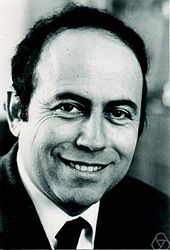Michael O. Rabin
Michael Oser Rabin ( Hebrew מיכאל עוזר רבין; born September 1, 1931 in Breslau ) is an Israeli computer scientist . He has made a particular contribution in the field of cryptology in connection with prime numbers and in the field of automaton theory .
life and work
Rabin was a son of the Russian-German historian Israel Rabin and the writer Ester Rabin . His brother Chaim Menachem Rabin , born in 1915, became a linguist, his sister Miriam Ben-Peretz, born in 1927, a pedagogue. The family emigrated to Palestine in 1935 . Rabin studied at the Hebrew University in Jerusalem (Masters 1953) and received his doctorate in Princeton in 1956 with Alonzo Church .
In the course of his career he worked with Kurt Gödel at the Institute for Advanced Study , was a professor at Yale University , the Weizmann Institute , the Technion , the University of California, Berkeley , MIT , the University of Paris , the Courant Institute of Mathematical Sciences of New York University , Caltech , ETH Zurich , Columbia University and King's College London , was a member of the IBM Science Advisory Committee from 1982 to 1994 and was a visiting researcher at Google Inc. in 2009. He is currently Thomas-J.-Watson -Professor of Computer Science at Harvard University and Professor at Hebrew University, of which he was Rector from 1972 to 1975.
Saharon Shelah is one of Rabin's doctoral students (including the Erdős Prize and Wolf Prize ).
Based on a method by Gary L. Millers , Rabin developed the Miller-Rabin algorithm for primality tests in 1975 . Together with Dana Scott he received the Turing Award for Computer Science in 1976 for their introduction of nondeterminism in Finite Automata and Their Decision Problem (IBM Journal Research and Development, Vol. 3, 1959). The Rabin cryptosystem , which he developed in 1979, comes from Rabin . In 1987 he and Richard M. Karp developed the Rabin-Karp algorithm for text searches. In 1981 he proposed the Rabin fingerprint .
In 2001, together with his student Yan Zong Bing , he proposed (in his basic principles) a demonstrably secure and at the same time supposedly practicable encryption method, see also. It is based on a one-time pad , the random number sequence of which is transmitted as part of a continuous unlimited sequence, for example via satellite. In a conventionally encrypted transmission path, the sender and receiver transmit the start time from which the random number sequence is used. However, the data transmission rate of the sequence is so high that storage is not possible, so that no decryption can be carried out afterwards even if the starting point in time is known.
Rabin's daughter Tal directs the Cryptography and Privacy Research Group at the Thomas J. Watson Research Center of IBM .
Awards (selection)
- 1970: Invited speaker at the International Congress of Mathematicians in Nice ( Decidability and definability in second order theories ).
- 1973 Rothschild Prize
- 1976: Turing Award
- 1980: Harvey Prize
- 1994: Tarski Lectures
- 1995: Israel Prize
- 2003: Paris Kanellakis Award
- 2004: Gödel Lecturer and EMET Prize
- 2010: Dan David Prize (in the "Future" category together with Leonard Kleinrock and Gordon Moore , for their contributions to computers and telecommunications)
- 2015: Dijkstra Prize
- Elected Member of the National Academy of Sciences , the Académie des sciences , the American Academy of Arts and Sciences (1975), the American Philosophical Society , the Israel Academy of Sciences , and the Royal Society
- Honorary title of New York University , the University of Haifa , the University of Bordeaux , the Open University of Israel , the Ben-Gurion University of the Negev and the University of Breslau
literature
- Rabin, Michael Oser , in: Werner Röder; Herbert A. Strauss (Ed.): International Biographical Dictionary of Central European Emigrés 1933-1945 . Volume 2.2. Munich: Saur, 1983 ISBN 3-598-10089-2 , pp. 934f.
Web links
- Rabin's profile at Harvard University (English)
Individual evidence
- ^ Gina Kolata, New York Times (February 20, 2001)
- ↑ Christian Cachin, Ueli Maurer: Unconditional security against memory-bounded adversaries in B. Kaliski (Ed.): Advances in Cryptology - CRYPTO'97, Volume 1233 of LNCS, Springer, 1997, pp. 209–225, ftp: // ftp.inf.ethz.ch/pub/crypto/publications/CacMau97b.pdf
| personal data | |
|---|---|
| SURNAME | Rabin, Michael O. |
| ALTERNATIVE NAMES | Rabin, Michael Oser (full name); מיכאל עוזר רבין (Hebrew) |
| BRIEF DESCRIPTION | Israeli computer scientist in the field of cryptology |
| DATE OF BIRTH | September 1, 1931 |
| PLACE OF BIRTH | Wroclaw |
